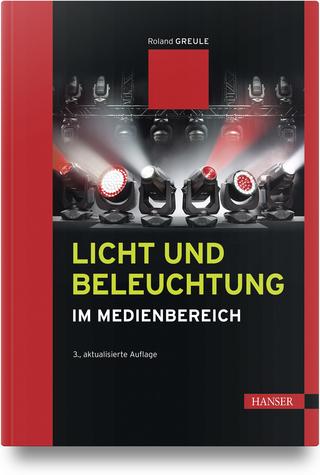
The Palgrave Handbook of Screen Production
Springer International Publishing (Verlag)
978-3-030-21746-4 (ISBN)
This handbook is an essential creative, critical and practical guide for students and educators of screen production internationally. It covers all aspects of screen production-from conceptualizing ideas and developing them, to realizing and then distributing them-across all forms and formats, including fiction and non-fiction for cinema, television, gallery spaces and the web. With chapters by practitioners, scholars and educators from around the world, the book provides a comprehensive collection of approaches for those studying and teaching the development and production of screen content. With college and university students in mind, the volume purposely combines theory and practice to offer a critically informed and intellectually rich guide to screen production, shaped by the needs of those working in education environments where 'doing' and 'thinking' must co-exist. The Palgrave Handbook of Screen Production fills an important gap in creative-critical knowledge of screen production, while also providing practical tools and approaches for future practitioners.
lt;p>Professor Craig Batty is Head of Creative Writing at the University of Technology Sydney, Australia, where he specialises in the theory and practice of screenwriting.
Associate Professor Marsha Berry is a writer and artist, specialising in mobile media practice, at RMIT University, Australia.
Dr Kath Dooley is a filmmaker, screenwriter and Senior Lecturer at Curtin University, Australia.
Dr Bettina Frankham is a practice-based researcher in digital media at the University of Technology Sydney, Australia.
Associate Professor Susan Kerrigan is a specialist in creative industries and screen production research at the University of Newcastle, Australia.
Collectively, the editors comprise the Research Sub-Committee of the Australian Screen Production Education and Research Association (ASPERA).
Part 1: Conceptualising the screen work: ideas, intentions, contexts.- Chapter 1 Creative filmmaking processes, procedures and practices: Embodied and internalised filmmaking agency.- Chapter 2 Commission, position and production: Intent and intervention in minority language programmes.- Chapter 3 Having something to say and saying it well.- Chapter 4 Understanding the underlying principles of the short film.- Chapter 5 Two screenplays, one writer, national voice.- Chapter 6 Off screen: Re-imagining animation.- Chapter 7 The Dr Egg Adventures: Incorporating user-generated content and user-testing strategies in pre-production conceptualization and development of a multi-platform storyworld.- Chapter 8 Taking place, screening place: Studying locations in television drama production.- Chapter 9 Wayfaring, co-presence and mobility: Conceptualising and re-conceptualising with smartphones.- Part 2:Developing the screen work: collaboration, imagination, distillation.- Chapter 10 Writing bodies: developing and scripting an embodied feature film screenplay.- Chapter 11 Putting theory into practice: Structuring the personal essay documentary, The Silences.- Chapter 12 Work-in-progress: The Writing of Shortchanged.- Chapter 13 Developing Baxter and Me: Maintaining authorial voice against industry pressures.- Chapter 14 Writers, producers and creative entrepreneurship in web series development.- Chapter 15 Local content producers: Co-creating communal stories and community in the Big Stories, Small Towns participatory documentary project.- Part 3: Realising the screen work: practice, process, pragmatism.- Chapter 16 Creative Practice: A Love Story.- Chapter 17 Creating and designing the contemporary soundtrack: A case study.- Chapter 18 The (braided) documentary voice: theorising the complexities of documentary making.- Chapter 19 Editing the observed: Evaluation and value creation processes in the editing of a feature documentary film.- Chapter 20 The beginning of a beautiful relationship: A case study exploration of collaborative creative practice.- Chapter 21 "Make it in post": Digital visual effects and the temporality of creative value in post-production.- Chapter 22 Trapped: A case study of international co-production.- Chapter 23 Production practices in the filming of German scripted reality shows.- Chapter 24 Embracing the TV commercial: Charms and challenges of selling on screen.- Part 4: Exhibiting the screen work: places, spaces, ecologies.- Chapter 25 Producing the other in international film festivals: Festival fund, address and the making of authenticity in Gabriel Mascaro's Neon Bull.- Chapter 26 The Live Cinema paradox: Continuity and innovation in live film broadcast, exhibition, and production.- Chapter 27 Digital disruption and innovation in distribution: Opportunities for research-based filmmaking in the new global screen ecology.- Chapter 28 Dispositifs at play: Artists' moving image in the gallery.- Chapter 29 Mobile reception: Materiality and locality with small screens.- Chapter 30 Appeasing the trolls: Contextualising new screen practices with smartphones.- Part 5: Teaching the screen work: pedagogies, practices, approaches.- Chapter 31 There is no 'e' in 'constraints': Teaching creativity in Higher Education screen production.- Chapter 32 "Is this degree practical or theoretical?" Screen and media education, studio-based teaching and signature pedagogies.- Chapter 33 Teaching screen arts in Australia: Challenges, opportunities and current trends.- Chapter 34 VR and screen education: An approach to assist student understanding of narrative emphasis, spatiality and structural elements within narrative VR.- Chapter 35 Teaching screenwriting through script development: Looking beyond the screenplay.
| Erscheinungsdatum | 11.12.2020 |
|---|---|
| Zusatzinfo | XXXIV, 482 p. 34 illus. |
| Verlagsort | Cham |
| Sprache | englisch |
| Maße | 155 x 235 mm |
| Gewicht | 783 g |
| Themenwelt | Kunst / Musik / Theater ► Film / TV |
| Schlagworte | Animation • Cinema • commission • Development • Distribution • Documentary • Drama • Education • filmmaking • Galleries • Ideas • multi-platform • Programmes • screenplay • Television • theory • Visual Effects |
| ISBN-10 | 3-030-21746-9 / 3030217469 |
| ISBN-13 | 978-3-030-21746-4 / 9783030217464 |
| Zustand | Neuware |
| Haben Sie eine Frage zum Produkt? |
aus dem Bereich


